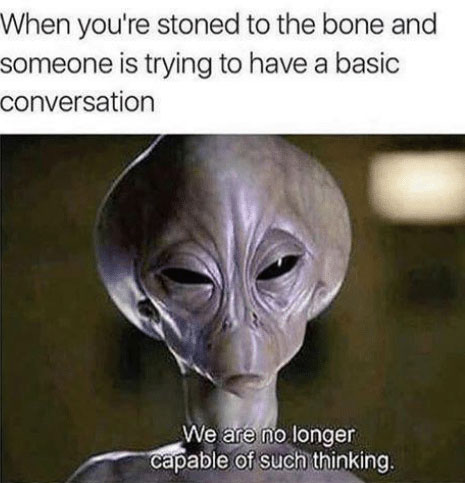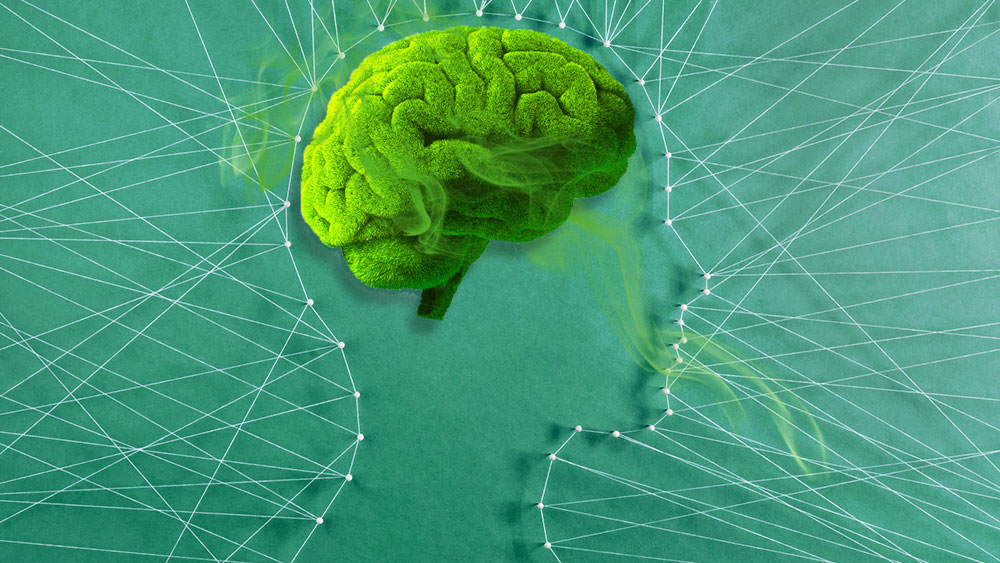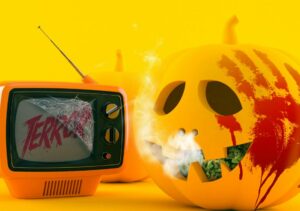Something definitely changes when we get high.
This can refer to a lot of different things, but we can all agree that a mind on cannabis functions unlike any other.
Of course, something similar could be said for many substances, but the psychoactivity which is largely caused by THC, most abundant cannabinoid, is quite special.
Achieving the perfect dose where there’s no tension or anxiety can be slightly difficult, but in that special state our brain really enjoys the “high”, and that’s when a lot of interesting stuff starts happening.
This is where high thoughts come to pass.
You’ve most likely already seen some of the weed memes, like this one for instance.

They’re a great way to demonstrate that something really changes with our thought-making processes when we’re high.
Naturally, humor isn’t the only thing that’s influenced by cannabis, and numerous artists purposefully used pot as a tool to increase their creativity.
Before anything else, we first need to figure out what happens inside the brain when cannabis is introduced, in regards to how our thoughts operate.
Because neuroscience is intensely complex, and people are rarely acquainted with the functions of numerous segments of the human brain, so some of this might seem a bit perplexing at first.
Luckily, scientists and researchers usually clarify their conclusions so we could understand them with more ease, and I personally took a lot of time in order to understand this subject matter better.
The double-blind study we we’re going to be looking at is from 1997, and it’s very important to us as it investigated what goes on in the human brain when THC is introduced, and because it’s the only one of its kind.
The primary objective of this research was to show how blood flow changes in the brain upon administering delta-9 tetrahydrocannabinol.
32 volunteers who reported previous exposure to cannabis (they had previous experiences with pot), were given either a placebo, or two intravenous doses of THC.
The MRI scans showed increased cerebral blood flow (CBF) in several regions of the brain when THC was injected, while the placebo group showed no detectable change.
The research team concluded the following:
“Behavioral manifestations of marijuana intoxication may be associated with increased functional activity of the brain, especially the frontal cortex, insula and cingulate gyrus.”
In order to understand what this means, we’re going to spend some time getting familiar with these areas of the brain.
Frontal cortex
I found an amazing video where the esteemed neuroendocrinologist and author Robert Sapolsky from Stanford University elaborates on the features and functions of the frontal cortex.
In the lecture, he explains:
The frontal cortex is the most human part of the brain. It is more complex in humans than in any other species, and it is also the most recently evolved part of the brain.
What does it do?
The frontal cortex does all sorts of complicated things, regulating executive behaviors like planning and strategizing, but most importantly, it makes you do the harder thing when it’s the right thing to do.
It makes you do something difficult when that’s what you should be doing.
It’s the nearest thing we got to a superego. It is the part of the brain saying:
“I wouldn’t do that if I were you, you are going to regret it”.
It has this role manifested in all sorts of domains.
For example, you’ve just been served the most atrocious meal on a party, the frontal cortex kicks in, and you say: “It’s absolutely delicious, I got to have the recipe.”
It keeps you from becoming a serial murderer, it keeps you constrained, keeps you in line.
It’s also something that is activated in a very dramatic way during early development, where most of us suddenly had to get a lot of frontal function – when we learned to be toilet trained.
This is something that soon moved from frontal executive control to implicit pathways, and most of us don’t have to think consciously about being toilet trained, but early on that was one of the big initial frontal tasks that had to be mastered.
The frontal cortex has a lot of other fascinating features. It just became clear that an important part of child development is your frontal cortex maturing.
Brain imaging shows that kids don’t have this area of the brain developed, and the frontal cortex is the last part of the brain to fully develop, around the age of 25.
This explains a lot of behaviour in freshman dorms. The frontal cortex takes forever to develop, and thus childhood is lived with a frontal cortex that doesn’t work very well yet.
There is a wonderful experimental paradigm: You place a child in a room, put a marshmallow in front of them, and say:
“I’m going out of the room. I’ll be back in a while, and if you want you can eat that marshmallow as soon as I’m gone. But if you don’t eat it right away, when I come back you can have two marshmallows”.
In other words, can you regulate your behaviour, or more precisely that impulsive desire to grab and eat the marshmallow? Kids are awfully challenged to hold on and not grab that marshmallow.
In fact, there’s a body of work showing that when we test 4-year olds, the longer they can hold on and not eat the marshmallow, the more frontal regulation they have at their behavior.
That is predictive of things like SAT scores a decade later in high school, and a mark of a frontal cortex that is developing in a very impressive manner.
To conclude, the frontal cortex (in combination with other areas of the brain), performs the very broad set of differing neurological functions we call cognition.
It plays an essential role in the creation of behavioral responses to both external and internal stimuli. The frontal cortex functions in association with other regions that are designed for individual mental assignments, and it participates with other sections of the brain in memory, learning, attention, and motivation.
It consolidates intricate perceptual information from sensory and motor cortices, as well as information from the parietal lobe (spatial sense and navigation etc), the temporal lobe (visual memory, language comprehension, and emotion association), in order to perform these complex cognitive operations.
An injured or insufficiently functional frontal cortex is associated with the inability to properly plan (executive function), changes in initiative and personality, and diminished creativity.
Insular cortex (Insula)
Located on both hemispheres of the brain, the insula is an important part of the cerebral cortex.
The insular complex is involved in numerous diverse functions, ranging from involvement in consciousness, perception and cognition, and emotions such as joy, happiness, anger, and disgust.
It also gives emotional context to physiological experiences, for instance, it helps us to experience that pain is unpleasant.
This section also plays a part in compassion and empathy and helps us to differentiate ourselves from the outside world, giving us a sense of self.
Other functions include maintaining homeostasis, which is a well-known phrase in the world of cannabis, meaning the balance of separate but interconnected systems of the body.
The endocannabinoid system also helps to regulate homeostasis on a cellular level.
The insula maintains homeostasis by interoceptive awareness, which allows us to be consciously aware of many bodily states, our heart beating for example.
Interoceptive awareness is essential for survival, as it provides us with real-time alertness of numerous functions within the body.
It also helps in reading other people’s emotions and various subtle social cues, which is crucial for interpersonal relationships.
Lastly the insular complex is linked to addictions and other conscious desires, and also motor control functions.
Cingulate gyrus
As the main part of the cingulate cortex, which is a very important component of the limbic system, the cingulate gyrus is involved with:
- Behaviour regulation (regulation of aggressive behaviours)
- Processing of emotions (coordination of sensory inputs with emotions, emotional responses to pain)
- Regulation of autonomous motor function
- Decision making
- Language expression and speech production (vocalization)
Disorders resulting from a damaged or dysfunctional cingulate gyrus include depression, anxiety and OCD, and individuals that suffer from a dysfunctional cingulate gyrus have issues with eating disorders, but also alcohol and drug abuse.
Now that we’ve acquainted ourselves with the functions of the brain sections important to this topic, we can now draw direct conclusions in regards to our thoughts on cannabis.
What does this tell us?
The double-blind study from 1997 reported that additional blood was circulating through these sections when THC was introduced intravenously, and as you may know already, no matter how the consumed cannabinoids travel in the blood until they reach and connect with the cells in the body that have endocannabinoid receptors, which are an essential part of our endocannabinoid system.
Throughout the brain different cell types express CB1 receptors, and as THC and other cannabinoids reach the receptors, they trigger a specific response from these cells.

In the case of a disease or a disorder, the introduction of cannabinoids means that the affected cells will change their behaviour in order to reinstate homeostasis, which is as previously mentioned a harmonious balance of each individual system of the body, but also the entire organism as a whole.
Because of this cannabis is used to battle so many different disorders and conditions, ranging from chronic pain, epilepsy, various issues of the gut, depression, anxiety, eating disorders, insomnia, PTSD and many more.
But when we look at what happens to our thoughts when cannabis is introduced, this situation is somewhat different.
Since cannabis (mostly because of THC) is psychoactive, this means that it alters brain function, changing cognition, perception, mood, consciousness, and behaviour.
This is why we fall into laughing fits when we’re high.
This also explains why we tend to think about unusual things and concepts, why thoughts become quicker and why we become more creative and freethinking.
After more than a decade of using cannabis, I slowly grew accustomed to the psychoactivity, and nowadays I’m rarely surprised by anything that happens when I toke up.
But when I first started enjoying pot it felt incredibly intense, so much stranger than being sober, and much more colorful and vivid than alcohol.
My friends and I used to spend countless hours discussing everything, and I honestly think cannabis made a really positive impact on my worldview and psyche in general.
Analyzing the psychoactivity of weed is complicated, just because there is so much going on at the same time. Weird thoughts, unusual sensations, peculiar associations, all of that hits you at once.
When we look at the features of the brain areas that are most influenced by THC, we’re able to see how some changes occur.
In the case of the frontal cortex, I can really feel the difference in the “superego” function when I’m high. I’m 31, so my frontal cortex should be fully developed by now.
I think the psychoactivity really lowers my ability to say no to myself.
I often eat a bunch of sugary crap, stay up too late, procrastinating and other things of that nature, something I’d always be able to stop myself from doing when I’m sober.
I also get a lot more confused than usual, so my planning and strategizing become haywired as well, which is also attributed to frontal cortex dysfunction.
On the other hand creativity surely peaks, but it’s oftentimes very hard to focus on one particular idea during the mental hurricane.
I also tend to be more auto-critical when I’m intoxicated, where I question a lot of things on which my mind is otherwise completely settled.
The insular cortex is also connected with consciousness, perception and cognition, and it definitely plays a role in the altered state we call being high.
It plays a capital role in creating a sense of self separate from the outside world, but on cannabis, I often feel much more connected to the people around me.
Lastly, in the case of the cingulate gyrus, we know that it’s responsible for regulating aggressive behaviours, and like everyone else, I become much more zen and mellow when I’m high.
This is definitely one of the biggest advantages of being stimulated by cannabis because being laid back is a wonderful thing.
Issues with a dysfunctional cingulate gyrus include depression and anxiety, which are disorders that can be mitigated and managed by consuming cannabinoids.
All in all the cerebral changes caused by cannabis are incredibly diverse, but now we know that pot increases neural activity in these very important areas of the brain.
This additional activity of our neurons lifts the mind into uncharted territories, and that’s why this sensation is called being high, because it’s a state that truly elevates our consciousness to new heights.





High Thoughts September 5, 2019 at 6:09 pm
Awsome article. I also am much more self-critical when i am high. I also process past actions and try to over think much. But that last few minutes and then i am like: "you only live once, lets relax" Sending some positive vibes your way!